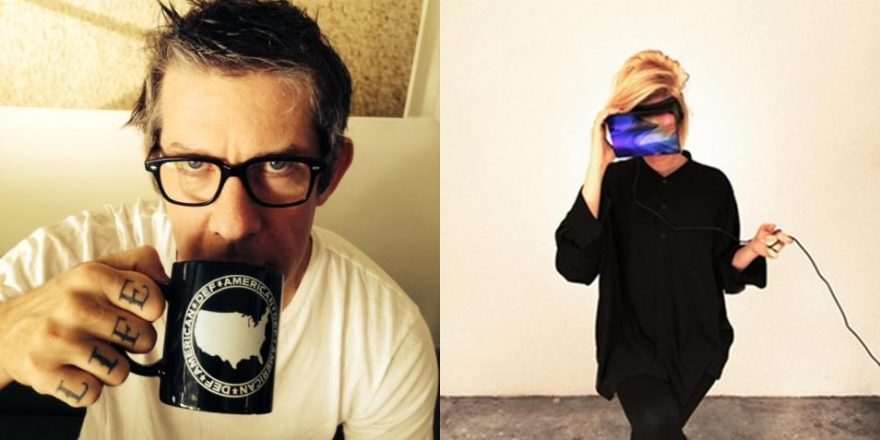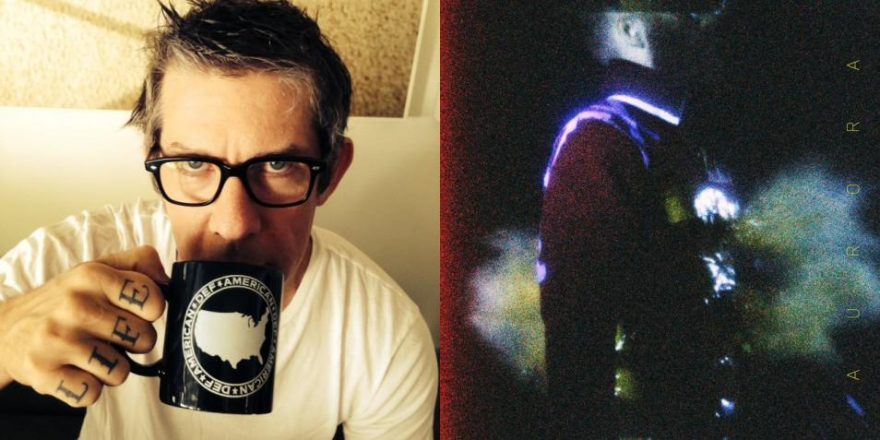Every weekday, the Talkhouse runs one piece by one musician, about one album. That’s about 250 pieces a year, and we still didn’t get to all the best that 2014 had to offer. So we asked some of our favorite Talkhouse writers to share their thoughts about a few of the more notable albums from last year.
— Michael Azerrad, Talkhouse editor-in-chief
The Future’s Void and the Present’s Echo Chamber
As a young man, I didn’t really know that people were supposed to have opinions about what I do. I took both praise and criticism too personally. But as artists, making things so that other folks have something to talk about is precisely what we do. If we choose to air a piece of our inner life for anybody’s scrutiny, we don’t get to choose how they feel about it. And now, I no longer want to. It took a while, but I’ve learned to value the conversation.
When the Talkhouse first reached out to me, the idea of musicians talking about music sounded compelling. I became convinced of the site’s potential after reading Nika Danilova’s talk about Olga Bell’s 2014 album Krai, written in the context of their shared Russian heritage. So convinced, I kept reading. I wrote a couple. Over time, a pattern began to emerge. I noticed how much time we waste on caveats and qualifiers, so much that we are frequently unclear about how we all, readers and writers alike, really feel. A statement that might be construed as negative often becomes so contorted by attempts to sound uncritical that I am left wondering what the writer actually thinks.
Can’t we all just agree here to get on with the business of talking? If reasonable and thoughtful people won’t speak their minds honestly and directly, then do we not cede the public conversation to only the loudest broadcasters or to the snap judgments of Twitter and the like? We’ve become simultaneously more sensitive and more shrill. Real conversation is getting squeezed out. We squander the great communication potential of our connected world when we fill it with caveats for the overly sensitive or with shouts from the grossly insensitive.
I am not interested in writing here because I believe I am right or wrong about someone else’s music in some objectively quantifiable way. I am writing because I am a musician who has thoughts and feelings about the music that I hear. Isn’t that a great reason for making music in the first place — that people hear it and have thoughts and feelings about it? So here I am now, hoping to write something that resembles what I’d like to read more often — musicians talking directly about music.
Years ago, I heard Thom Yorke refer to miss-able, or ordinary, music as “fridge buzz” — music that sounds as mundane, replaceable and unnecessary as the buzz of a refrigerator. I’ve been haunted by that vivid description ever since. I always ask myself if my work passes this test: is what I’ve made singular in some way, or could it have been done by anyone? Do we already have this music, yes or no? Personally, when it comes to the music I’ve made, I have found both answers to be true.
We don’t need more of the same. We need different. We need more recognizable signal and less background noise. I would argue that there is more signal than noise on EMA’s latest record, The Future’s Void. Erika M. Anderson — hence EMA — is at her best when she is at her most unusual. She distinguishes herself most clearly from “fridge buzz” when she sounds the most like herself.
When I first heard the opening track, “Satellites,” I was excited. It felt like Anderson was moving forward. The song felt like it was not just the opening track of a record, it was the opening of a whole new chapter for EMA. I’m a fan of her previous album and official solo debut, 2011’s Past Life Martyred Saints, and I’ve probably listened to the song “California” as often as any song, by any artist, since its release. So when I listened to the first two minutes of white noise and synth of advance single “Satellites,” I was feeling its intended sense of anticipation. I was intrigued. The drumbeat kicks in and drives the promised payoff for its two final minutes. Very cool. Promising. I was in. Anderson had taken a next step. I looked forward to the album. I wanted more.
But when the next song came out some time later, I was disappointed. “So Blonde” seemed to share little of the sense of newness offered by its predecessor. On first listening, “So Blonde” sounded familiar, too familiar to hold my attention. I don’t understand the literal intention of the lyrics, but it feels like irony with a sort of sneering “so blonde” refrain. This song could be by lots of artists. It needn’t be EMA. On subsequent listenings to the record, I skip this one. There is no sense that by the end of the song you are in a different place than when the song began, which means that I couldn’t find the feeling that characterizes my favorite Anderson songs: of being transported or displaced by the music.
Happily, when the entire record was later released, “Satellites” turned out to be a better indicator of the sound of the rest of The Future’s Void, as the haunting spirit that characterizes my favorite EMA returns on the next track, “3Jane.” This sounds like the most singularly Andersonian song on the record; I could have heard this song without introduction and I would have recognized it as EMA. It is bathed in reverb, like just about everything else that I write and listen to these days. It’s got a lovely melancholic Americana feel. In addition to its smoky similarity to Past Life Martyred Saints (especially “California”), “3Jane” also reminds me of some of her previous band, Gowns, which specialized in mid-tempo tunes with a simply sung, sometimes spoken, main vocal. Here, Anderson’s effortless musicality expresses itself in a subtle musical detail: the cadence with the words “modern disease” in the middle of the song resolves melodically upward because the song isn’t yet finished, but then at the end of the song, the same line and melody return, this time with a resolution that lilts downward as the song comes to an end.
The sequencing of the record’s first three tracks feels like a list of three singles rather than the first three tracks of an album. Conversely, the back half of the record, starting with “Cthulu,” feels like it was sequenced with a more traditional album shape in mind.
“Cthulu” introduces itself with little splashes of white noise. The main vocal then carries the rest of the song with an unmistakably bluesy feel. I have a personal aversion, generally speaking, to choosing these blue notes for music other than the blues. For the non-musician, blue notes are basically notes that lie outside the “normal” notes in the key of a song. In the right hands, mostly blues and r&b artists, they can be powerfully expressive choices. But that same character makes them potentially distracting to my ear when used almost anywhere else. If they aren’t emotionally convincing, then they only serve to divert my attention from the aspects of music that I find most interesting these days, in particular on this record, and more generally in my other music listening and in the music I’m writing: timbre, texture, mood.
I will say that the appearance of these bluesy choices works a little better here because they combine with lyrics that give the first half of the song a seemingly intentional Southern Baptist-revival feel, with three consecutive lyric lines that contain the word “redemption.” The first half of the song then shifts out of a breakdown in the middle with a melding of keys, inserting a prominent major third above the C in a song in C minor, producing a decidedly ’90s-era Nine Inch Nails synth progression.
I could use the next song’s title, “Smoulder,” to describe the beautiful use of distortion on the sometimes wailing main vocal. It feels like the vocal is a bright-hot glowing orange wire producing a constant wake of ash that might burn itself out before the end of the song. Her vocal cleans up on the next one, “Neuromancer,” a halting stomp of a song with a vocal that sounds, in its higher reaches, remarkably like Karen O of the Yeah Yeah Yeahs. It rests in a bed of synthesizers that lie static in the center of the song, just one of this album’s many great, slowly evolving synth textures. I suspect that Anderson and I listen to some of the same stuff: arty electronic drone-ish music (I’m sure there exists a snappy marketing title for this, I just don’t know it) from folks like Dan Deacon, William Basinski, Tim Hecker and Oren Ambarchi.
During the first few bars of the next song, “When She Comes,” I am reminded of the song “Paint Work” off the Fall’s album This Nation’s Saving Grace (1985). Then during the noisy breakdown, and through the end of the song, I’m thinking of some of the more sedate ballads of the Velvet Underground. But I think “When She Comes” ultimately lacks the deliberate scruffiness and charming character of those reference points. I wonder if this record needed this song. It not only doesn’t sound like it belongs on this record, it doesn’t sound like it belongs in the same century as the rest of the record. It does provide a sort of reset button at this point in the sequencing of the songs, and maybe that’s why Anderson put it here — to set up the last three songs. But I would argue that the next track, “100 Years,” does the same job and does it while remaining consistent with the rest of the record. Either way, “100 Years” is one of my favorite tracks on the record. It’s the sort of piece that might seem pointless if you’re listening on your laptop in a noisy environment. But on headphones I found it affecting. It’s subtle. Spare. Mostly vocal with basic piano chords in a distant bed of reverb. Both those elements are then adorned with little orchestral embers that make some interesting, surprising and ultimately beautiful accompaniment.
The next track benefits from the “100 Years” reset. It feels like an arrival. It’s the point in a long journey when you turn around and consider the distance you’ve traveled. Appropriately, it’s titled “Solace.” It feels like relief given or a burden lightened — not lifted entirely, but lightened. It’s perfectly placed.
If “Solace” is the arrival at a final light summit, then “Dead Celebrity” is the denouement, the resolution after the climax of the story. It feels traditional, like “Amazing Grace” meets “Taps.” Funerary. Lullaby. It is an end. Sleep. She sings of the real and imagined relationship with the dead celebrity. “Who can love us? Who can judge us?” For better and worse, we all can.
In our social media-connected world, we have an abundance of judges. We are all a few moments away from worldwide distribution of our opinions. But that is not the same as a point of view. Opinions are ephemeral. They are a moment, a feeling. But if you pause and let that opinion grow, inform it, consider it, then you have a point of view. I want to hear and share points of view. I want an artist to express their point of view with clarity and directness, and I want us to talk about it.
The value of a point of view works in both directions. Not just when we play the role of critic, but as artists as well. A point of view is the lens we look through as we write. It is how we organize. In a culture of all possible songs at any time, a record without a clear point of view becomes indistinguishable from everything else. It’s a list of songs that might easily disappear into the shuffle mode of our global fridge buzz. With a focused point of view, an album has the ability to create a larger space in the world, songs moving together — the whole becoming greater than the sum of its parts. Most of this record is an example of this clear point of view. I mentioned when I thought it wavered.
Have a point of view, think about it. Artist or critic. Listen. Consider. Respond. If you aren’t normally the critic, think about and create your informed opinion, then summon the courage to express it. If you are the artist, learn to listen. Learn to take a hit, remain undistracted, and you will learn to value hearing informed opinion about your work. You will see it for what it can be: helpful. And you will come to learn, as Anderson puts it in “Neuromancer,” “I might lose some fur, but I will survive.”









